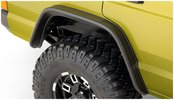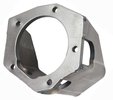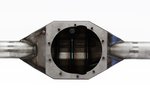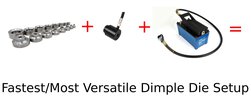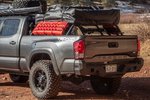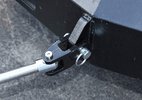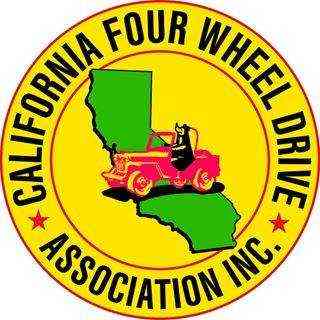4 Ways to Adapt Toyota IFS Steering to Toyota High Steer

High steer steering is the most common setup for strong, high clearance steering on 4x4 Toyota 4Runners and pickups/minis.
It puts the tie rod and drag link over your leaf springs, protecting them and improving steering linkage angles. But you still need to attach the drag link to your steering box somehow, which is a little tricky.
How do you do it? Read on.
- Pick a Pitman: All About Stock and Aftermarket Toyota Pickup and 4Runner Pitman Arms
- 5 Ways to Upgrade Toyota Knuckle Studs
You have a Toyota axle with some sort of high steer kit, or you're planning to get one. If you're planning to get a high steer kit, use the info here to figure out how the kit will connect to your steering box.
You have a Toyota IFS steering box. If you don't know, these boxes come out of '86+ trucks that have independent front suspension. The IFS steering boxes are better suited to high steer than the push-pull boxes on '79-'85 Toyotas because the pitman arm swings side-to-side instead of front-to-back. This is a standard swap item on early Toys.
You need to adapt the high steer kit to your IFS box pitman arm.
Taper - For Toyotas, aftermarket pitman arms are usually tapered for the Toyota Land Cruiser FJ80 drag link end. However, if you're installing full width axles, you might be interested in a GM ES2027 drag link end, which is a high misalignment one ton drag link end. These are easily available so that you can adapt your Toyota IFS to 3/4 or 1 ton axles.
Drop - Aftermarket Toyota pitman arms come flat or with various degrees of drop. With higher lifts, extra drop helps to keep your drag link parallel to the ground so that your steering works safely and predictably. If you're putting an IFS steering box on a '79-'85 or moving your steering box forward on an '86-'95, having drop options can help you mount your steering box in the best location. For low-lift setups, a flat arm is more appropriate. However, there tends to be a lot more fab work involved to get a truck low enough to require a flat arm. A standard SAS or lift kit will usually use a drop arm.
Swing length - Swing length is the distance from the splined sector shaft hole to the center of the drag link stud or hole. While you don't necessarily have a lot of choice in this, you should be aware that some manufacturers design their pitman arms to work with their high steer steering arms so that you have optimized handling and turning radius. If you haven't bought your high steer kit yet, it's worth seeing if a machined pitman arm comes packaged with the manufacturer's kit and whether the high steer arms and pitman arm are built to work together.
Following are 4 ways of getting your drag link connected to your steering box. If you're here you might also want to read a little about Toyota pitman arms.
The Typical Setup
The first thing you should note is that many Toyota high steer kits come with 23mm FJ80 tie rod ends standard. These are the strongest and largest Toyota tie rod ends available. They are easy to find online and should be relatively easy to find if you break down away from home. We're going to assume a few things for this article:
The Issue with Attaching High Steer
The stock Toyota IFS pitman arm has a ball joint with a stud at the drag link connection, not a tapered hole. A tapered hole in the end of a pitman arm is fairly standard on other vehicles and required for fitting high steer to your Toyota. Most drag links for wheeling have a tie rod/drag link end with a stud sticking out that would be inserted into the tapered hole in the pitman arm. There are a few ways of dealing with this that require various levels of cash, tools, and skill.


The stock pitman arm on independent front suspension Toyota minis and 4Runners has a ball joint to connect the drag link. On the left is the splined steering box sector shaft. The pitman arm is held on to the sector shaft with a large nut.
The stock Toyota independent front suspension uses a ball joint. Most of us expect the ball joint to be in the drag link, not the pitman arm, so this is one place where you need to evaluate some options.
IFS Steering Box to Aftermarket High Steer Connection Options
Option 1. The Drag Link Adapter: Adapt the drag link to the pitman arm
The threaded end of this adapter screws into your 23mm aftermarket high steer drag link. The tapered hole fits your stock Toyota pitman arm's ball joint taper.
The drag link adapter is easy and inexpensive. You keep your stock pitman arm and leave the ball joint in it. You don't have to press out the ball joint or remove your pitman arm. The adapter has a male threaded end that's installed into your drag link just like a tie rod/drag link end. On the other end of the adapter is a tapered hole that accepts the ball joint stud from the pitman arm. This setup has the advantage of being a bolt-in, no-welding, no-fabrication setup. It requires no expensive tools to install and will probably take you 15 minutes to put in.
The disadvantages are that you still have your stock pitman arm, which will be weaker than an aftermarket part and doesn't offer any flexibility in terms of height (since you can buy variable height pitman arms for Toyotas). Unless it comes as part of a kit, you'll end up with an extra drag link end as well, so if you choose the adapter it's more cost effective to buy your high steer kit with the drag link adapter already included.
Lastly, you should inspect the ball joint in your pitman arm and see that it's in good shape before using it. When you buy a Toyota high steer kit you'll end up with all new joints, but not if you use the drag link adapter with your old pitman arm ball joint.
Option 2. A Pitman Arm Insert: Adapt the pitman arm to the drag link
Once you press out the ball joint in the stock Toyota pitman arm, you can press in and TIG weld this tapered insert. This makes your Toyota pitman arm like a "normal" pitman.
This machined insert replaces the ball joint in the pitman arm. These inserts are tapered to fit your drag link end and are extremely cheap. The existing ball joint in the Toyota pitman arm needs to be pressed out, the insert pressed in, then the insert welded to the pitman arm. Obviously, this is an extremely important joint. MIG and stick welding are too imprecise for this type of work, so it should be done by an experienced TIG welder. This is probably a $60 job at your local welding shop. Suddenly, the drag link adapter is looking better!
If you're using a complete Toyota high steer kit, you'll be able to use all the included tie rod and drag link ends, so you won't end up with any leftover new parts. As with the drag link adapter, you still end up with the stock Toyota pitman arm which is weaker than aftermarket and has no options for pitman arm drop. The only shop that currently sells a Toyota pitman arm insert is Marlin Crawler.
Option 3. A New Pitman Arm: Replace the pitman arm
A forged dropped steering arm is an easy way to adapt an IFS steering box to an FJ80 drag link end. An easy, bolt-on mod.
Aftermarket machined Toyota pitman arms are available with different amounts of drop to fit with your steering box location and amount of lift. They also come with a variety of tapers so that you can fit Toyota tapers, GM tapers, and heim joints.
This Trail Gear pitman arm it flat to tuck your drag link up higher than a drop arm. It has a FJ80 taper for use with the standard FJ80 tie rod ends.
A replacement pitman arm is typically about twice the cost (or more) of the drag link adapter. To install it, you just pop off your old Toyota pitman arm, put the new pitman on, and attach the drag link. This is maybe a little harder than doing the drag link adapter, and you'll need a pitman arm puller (which is a good tool to have anyway).
You can either go with a forged drop arm, a forged flat arm, or a machined arm (more expensive and more options). When you're done you'll have a very strong pitman arm. Different manufacturers offer different options:
We have a pretty long list of stock and aftermarket Toyota pitman arms that you might be interested in.
Option 4. Build Your Own Pitman Around a Splined Insert
You can use this insert to build your own pitman arm that will work with a Toyota IFS steering box. This makes it easy when you don't have the gear to cut splines, but you do have the knowledge and equipment to weld chromoly steering parts.
For custom setups you might want to build your own pitman arm. You can buy chromoly splined pitman arm inserts that will work with the Toyota IFS steering box splined sector shaft. This is great since most people don't have tooling to make internal splines. Chromoly requires special welding procedures and should be TIG welded, so this job requires some special tools and a very high degree of fabrication proficiency. If you don't have the knowledge or tools to do this, building your own Toyota pitman arm is absolutely not for you.
Which One Should I Choose?
For most people, the drag link adapter or a new pitman arm make the most sense. You can essentially bolt your high steer steering onto your Toyota without any particularly special tools or knowledge required. Between the two, pick the drag link adapter to save some money. Pick the new pitman arm if you need something stronger and you want it to be "tunable" so that you can put your IFS steering box in the best location.
The pitman arm tapered insert is only useful if you can get the welding done (perfectly!) for free. And of course, if you're going to build your own pitman arm, you probably know want you want and are already ordering the part!
Last updated: September 5, 2019







